Trifocal intraocular lenses versus bifocal intraocular lenses after cataract extraction among participants with presbyopia
- PMID: 32584432
- PMCID: PMC7388867
- DOI: 10.1002/14651858.CD012648.pub2
Trifocal intraocular lenses versus bifocal intraocular lenses after cataract extraction among participants with presbyopia
Update in
-
Trifocal intraocular lenses versus bifocal intraocular lenses after cataract extraction among participants with presbyopia.Cochrane Database Syst Rev. 2023 Jan 27;1(1):CD012648. doi: 10.1002/14651858.CD012648.pub3. Cochrane Database Syst Rev. 2023. PMID: 36705482 Free PMC article.
Abstract
Background: Presbyopia occurs when the lens of the eyes loses its elasticity leading to loss of accommodation. The lens may also progress to develop cataract, affecting visual acuity and contrast sensitivity. One option of care for individuals with presbyopia and cataract is the use of multifocal or extended depth of focus intraocular lens (IOL) after cataract surgery. Although trifocal and bifocal IOLs are designed to restore three and two focal points respectively, trifocal lens may be preferable because it restores near, intermediate, and far vision, and may also provide a greater range of useful vision and allow for greater spectacle independence in individuals with presbyopia.
Objectives: To assess the effectiveness and safety of implantation with trifocal versus bifocal IOLs during cataract surgery among participants with presbyopia.
Search methods: We searched the Cochrane Central Register of Controlled Trials (CENTRAL) (which contains the Cochrane Eyes and Vision Trials Register) (2019, Issue 9); Ovid MEDLINE; Embase.com; PubMed; ClinicalTrials.gov; and the World Health Organization (WHO) International Clinical Trials Registry Platform (ICTRP). We did not use any date or language restrictions in the electronic search for trials. We last searched the electronic databases on 26 September 2019. We searched the reference lists of the retrieved articles and the abstracts from the Annual Meeting of the Association for Research in Vision and Ophthalmology (ARVO) for the years 2005 to 2015.
Selection criteria: We included randomized controlled trials that compared trifocal and bifocal IOLs among participants 30 years or older with presbyopia undergoing cataract surgery.
Data collection and analysis: We used standard Cochrane methodology.
Main results: We identified five studies conducted in Europe with a total of 175 participants. All five studies assessed uncorrected distance visual acuity (primary outcome of the review), while some also examined our secondary outcomes including uncorrected near, intermediate, and best-corrected distance visual acuity, as well as contrast sensitivity. Study characteristics All participants had bilateral cataracts with no pre-existing ocular pathologies or ocular surgery. Participants' mean age ranged from 58 to 64 years. Only one study reported on gender of participants, and they were mostly women. We assessed all the included studies as being at unclear risk of bias for most domains. Two studies received financial support from manufacturers of lenses evaluated in this review, and at least one author of another study reported receiving payments for delivering lectures with lens manufacturers. Findings All studies compared trifocal versus bifocal IOL implantation on visual acuity outcomes measured on a LogMAR scale. At one year, trifocal IOL showed no evidence of effect on uncorrected distance visual acuity (mean difference (MD) 0.00, 95% confidence interval (CI) -0.04 to 0.04; I2 = 0%; 2 studies, 107 participants; low-certainty evidence) and uncorrected near visual acuity (MD 0.01, 95% CI -0.04 to 0.06; I2 = 0%; 2 studies, 107 participants; low-certainty evidence). Trifocal IOL implantation may improve uncorrected intermediate visual acuity at one year (MD -0.16, 95% CI -0.22 to -0.10; I2= 0%; 2 studies, 107 participants; low-certainty evidence), but showed no evidence of effect on best-corrected distance visual acuity at one year (MD 0.00, 95% CI -0.03 to 0.04; I2= 0%; 2 studies, 107 participants; low-certainty evidence). No study reported on contrast sensitivity or quality of life at one-year follow-up. Data from one study at three months suggest that contrast sensitivity did not differ between groups under photopic conditions, but may be worse in the trifocal group in one of the four frequencies under mesopic conditions (MD -0.19, 95% CI -0.33 to -0.05; 1 study; I2 = 0%, 25 participants; low-certainty evidence). In two studies, the investigators observed that participants' satisfaction or spectacle independence may be higher in the trifocal group at six months, although another study found no evidence of a difference in participant satisfaction or spectacle independence between groups. Adverse events Adverse events reporting varied among studies. Two studies reported information on adverse events at one year. One study reported that participants showed no intraoperative or postoperative complications, while the other study reported that four eyes (11.4%) in the bifocal and three eyes (7.5%) in the trifocal group developed significant posterior capsular opacification requiring YAG capsulotomy. The certainty of the evidence was low.
Authors' conclusions: There is low-certainty of evidence that compared to bifocal IOL, implantation of trifocal IOL may improve uncorrected intermediate visual acuity at one year. However, there is no evidence of a difference between trifocal and bifocal IOL for uncorrected distance visual acuity, uncorrected near visual acuity, and best-corrected visual acuity at one year. Future research should include the comparison of both trifocal IOL and specific bifocal IOLs that correct intermediate visual acuity to evaluate important outcomes such as contrast sensitivity and quality of life.
Copyright © 2020 The Cochrane Collaboration. Published by John Wiley & Sons, Ltd.
Conflict of interest statement
Diego Zamora‐de la Cruz: none known. Karla Zúñiga‐Posselt: none known. John Bartlett: none known. Mario Gutierrez: none known. Samuel A Abariga: none known.
Figures

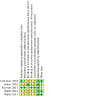

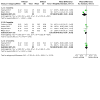
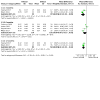
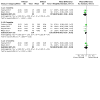


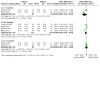



References
References to studies included in this review
Cochener 2016 {published data only}
-
- Cochener B. Prospective clinical comparison of patient outcomes following implantation of trifocal or bifocal intraocular lenses. Journal of Refractive Surgery 2016;32(3):146-51. - PubMed
Jonker 2015 {published data only}
-
- Jonker SM, Bauer NJ, Makhotkina NY, Berendschot TT, den Biggelaar FJ, Nuijts RM. Comparison of a trifocal intraocular lens with a +3.0 D bifocal IOL: results of a prospective randomized clinical trial. Journal of Cataract and Refractive Surgery 2015;41(8):1631-40. - PubMed
Kaymak 2017 {published data only}
-
- Alió JL, Kaymak H, Breyer D, Cochener B, Plaza‐Puche AB. Quality of life related variables measured for three multifocal diffractive intraocular lenses: a prospective randomised clinical trial. Clinical and Experimental Ophthalmology 2018;46(4):380-8. - PubMed
-
- Kaymak H, Breyer D, Alio JL, Cochener B. Visual performance with bifocal and trifocal diffractive intraocular lenses: a prospective three-armed randomized multicenter clinical trial. Journal of Refractive Surgery 2017;33(10):655-62. - PubMed
Mojzis 2014 {published data only}
-
- Mojzis P, Kukuckova L, Majerova K, Liehneova K, Pinero DP. Comparative analysis of the visual performance after cataract surgery with implantation of a bifocal or trifocal diffractive IOL. Journal of Refractive Surgery 2014;30(10):666-72. - PubMed
References to studies excluded from this review
ACTRN12607000601437 {published data only}
-
- ACTRN12607000601437. A Randomised, Single Centre Study of the Equivalence of Two Intraocular Lenses Used in Cataract Surgery [A Randomised, Single Centre Study of the Equivalence in Safety and Efficacy of Two Intraocular Lenses Used in Cataract Surgery]. https://www.australianclinicaltrials.gov.au/anzctr/trial/ACTRN1260700060... First received 1 June 2007.
Aose 2006 {published data only}
-
- Aose M, Matsushima H, Nagata M, Matui E, Obara Y, Yoshida S, et al. Characteristics of different types of hydrophobic acrylic intraocular lenses and clinical evaluation during early postoperative period. Investigative Ophthalmology and Visual Science 2006;47(13):610.
Bilbao‐Calabuig 2016 {published data only}
-
- Bilbao-Calabuig R, Gonzalez-Lopez F, Amparo F, Alvarez G, Patel SR, Llovet-Osuna F. Comparison between mix-and-match implantation of bifocal intraocular lenses and bilateral implantation of trifocal intraocular lenses. Journal of Refractive Surgery 2016;32(10):659-63. - PubMed
ISRCTN64155646 {published data only}
-
- ISRCTN64155646. Evaluation of post-operative dysphotopsia and spectacles independence after bilateral multifocal intraocular lens (IOL) implantation for cataract surgery and refractive lens exchange: Acri.LISA® 366D versus AcrySof® SN6AD1 randomised clinical trial. www.isrctn.com/ISRCTN64155646 (first received 1 September 2010).
Kim 2019 {published data only}
Lesueur 2000 {published data only}
-
- Lesueur L, Gajan B, Nardin M, Chapotot E, Arne JL. Comparison of visual results and quality of vision between two multifocal intraocular lenses. Multifocal silicone and bifocal PMMA [Resultats comparatifs visuels et qualite de vision de deux implants multifocaux. Silicone multifocal et PMMA bifocal]. Journal francais d'ophtalmologie 2000;23(4):355-9. - PubMed
Leyland 2000 {published data only}
-
- Leyland MD, Bloom PA, Goolfee F, Langan L, Lee NA. Prospective randomised trial of bilateral implantation of multifocal, bifocal, and monofocal intraocular lenses. American Academy of Ophthalmology 2000;104.
Leyland 2002 {published data only}
-
- Leyland MD, Langan L, Goolfee F, Lee N, Bloom PA. Prospective randomised double-masked trial of bilateral multifocal, bifocal or monofocal intraocular lenses. Eye 2002;16(4):481-90. - PubMed
Liu 2018 {published data only}
-
- Liu X, Xie L, Huang Y. Comparison of the visual performance after implantation of bifocal and trifocal intraocular lenses having an identical platform. Journal of Refractive Surgery 2018;34(4):273‐80. - PubMed
Maurino 2015 {published data only}
-
- Maurino V, Allan BD, Rubin GS, Bunce C, Xing W, Findl O. Quality of vision after bilateral multifocal intraocular lens implantation: a randomized trial—AT LISA 809M versus AcrySof ReSTOR SN6AD1. Ophthalmology 2015;122(4):700-10. - PubMed
NCT03117426 {unpublished data only}
-
- NCT03117426. A randomised evaluation of visual function after bilateral implantation of two types of presbyopia-correcting IOLs. clinicaltrials.gov/ct2/show/NCT03117426 (first received 18 April 2017).
NTR3556 {published data only}
-
- NTR3556. A randomized, subject-blinded evaluation of visual function after bilateral implantation of two types of presbyopia-correcting multifocal IOLs. who.int/trialsearch/Trial2.aspx?TrialID=NTR3556 (first received 2 August 2012).
Paul 2016 {published and unpublished data}
-
- Paul R, Rayside M. Comparison of 3 presbyopic correcting intraocular lenses. Clinical and Experimental Ophthalmology 2016;44(Suppl 1):71.
Postolache 2015 {published and unpublished data}
Qu 2018 {published data only}
-
- Qu S, Chen C, Lin S, Di H, Li L, Wang YF, et al. Comparison on the visual quality after different multifocal lens implantation in cataract patients. International Eye Science 2018;18(3):486-90.
Richter‐Mueksch 2002 {published data only}
-
- Richter-Mueksch S, Weghaupt H, Skorpik C, Velikay-Parel M, Radner W. Reading performance with a refractive multifocal and a diffractive bifocal intraocular lens. Journal of Cataract and Refractive Surgery 2002;28(11):1957-63. - PubMed
Ruiz‐Mesa 2017 {published data only}
-
- Ruiz-Mesa R, Abengozar-Vela A, Aramburu A, Ruiz-Santos M. Comparison of visual outcomes after bilateral implantation of extended range of vision and trifocal intraocular lenses. European Journal of Ophthalmology 2017;27(4):460-5. - PubMed
Schmidinger 2006 {published data only}
-
- Schmidinger G, Geitzenauer W, Hahsle B, Klemen UM, Skorpik C, Pieh S. Depth of focus in eyes with diffractive bifocal and refractive multifocal intraocular lenses. Journal of Cataract and Refractive Surgery 2006;32(10):1650-6. - PubMed
Skiadaresi 2015 {published data only}
-
- Skiadaresi E. Re: Maurino et al.: Quality of vision after bilateral multifocal intraocular lens implantation: a randomized trial—AT LISA 809M versus AcrySof ReSTOR SN6AD1 (Ophthalmology 2015;122:700-10). Ophthalmology 2015;122(9):e56-7. - PubMed
Szweda 1999 {published data only}
-
- Szweda E, Olejarz E, Kaluzny J, Czajkowski G, Seredyka-Burduk M. Comparative evaluation of visual acuity after cataract extraction with monofocal, bifocal or progressive lenses implantation [Ocena porownawcza ostrosci wzroku po operacji zacmy z wszczepem soczewek tylnokomorowych jednoogniskowych, dwuogniskowych i progresywnych]. Klinika Oczna 1999;101(6):437-9. - PubMed
Yu 2016 {published and unpublished data}
-
- Yu S, Kim YI, Ha SW, Lee GJ, Lee KW, Park YJ. Comparison of the visual outcomes after cataract surgery with implantation of a bifocal and trifocal diffractive intraocular lens. Journal of the Korean Ophthalmological Society 2016;57(3):405-12.
Zamora‐de‐la‐Cruz 2018 {published data only}
-
- Zamora-de-la-Cruz D, Garzón M, Chávez-Mondragón E. Comparison of visual results and quality of vision after bilateral implantation of trifocal intraocular lenses versus bifocal intraocular lenses. Revista Mexicana de Oftalmologia 2018;92(2):62-9.
References to studies awaiting assessment
de Carneros‐Llorente 2019 {published data only}
-
- Carneros-Llorente AM, Carneros AM, Carneros-Llorente PM, Jiménez-Alfaro I. Comparison of visual quality and subjective outcomes among 3 trifocal intraocular lenses and 1 bifocal intraocular lens. Journal of Cataract and Refractive Surgery 2019;45(5):587-94. - PubMed
Additional references
Bae 2015
Calladine 2012
Carson 2014
Cochener 2012
Covidence [Computer program]
-
- Veritas Health Innovation Covidence. Version 10 November 2018. Melbourne: Veritas Health Innovation, 2019.Available at www.covidence.org.
Deeks 2017
-
- Deeks JJ, Higgins JP, Altman DG, editor(s). Chapter 9: Analysing data and undertaking meta-analyses. In: Higgins JPT, Churchill R, Chandler J, Cumpston MS, editor(s). Cochrane Handbook for Systematic Reviews of Interventions version 5.2.0 (updated June 2017). Cochrane, 2017. Available from www.training.cochrane.org/handbook.
Gatinel 2013
-
- Gatinel D, Houbrechts Y. Comparison of bifocal and trifocal diffractive and refractive intraocular lenses using an optical bench. Journal of Cataract and Refractive Surgery 2013;39(7):1093-9. - PubMed
Glasser 1999
-
- Glasser A, Campbell MC. Biometric, optical and physical changes in the isolated human crystalline lens with age in relation to presbyopia. Vision Research 1999;39(11):1991-2015. - PubMed
Higgins 2017
-
- Higgins JPT, Altman DG, Sterne JAC, editor(s). Chapter 8: Assessing risk of bias in included studies. In: Higgins JPT, Churchill R, Chandler J, Cumpston MS, editor(s). Cochrane Handbook for Systematic Reviews of Interventions version 5.2.0 (updated June 2017). Cochrane, 2017. Available from www.training.cochrane.org/handbook.
Higgins 2019
-
- Higgins JPT, Eldridge S, Li T, editor(s). Chapter 23: Including variants on randomized trials. In: Higgins JPT, Thomas J, Chandler J, Cumpston M, Li T, Page MJ, Welch VA, editor(s). Cochrane Handbook for Systematic Reviews of Interventions version 6.0 (updated July 2019). Cochrane, 2019. Available from www.training.cochrane.org/handbook.
Hodge 1995
-
- Hodge WG, Whitcher JP, Satariano W. Risk factors for age-related cataracts. Epidemiologic Reviews 1995;17(2):336-46. - PubMed
Jin 2019
Kohnen 2009
Kretz 2015a
Kretz 2015b
Langendam 2013
Law 2014
-
- Law EM, Aggarwal RK, Kasaby H. Clinical outcomes with a new trifocal intraocular lens. European Journal of Ophthalmology 2014;24(4):501-8. - PubMed
Lesieur 2012
-
- Lesieur G. Outcomes after implantation of a trifocal diffractive IOL [Resultats apres implantation d'un implant trifocal diffractif]. Journal Francais d'Ophtalmologie 2012;35(5):338-42. - PubMed
Li 2014
Mantyjarvi 2001
-
- Mantyjarvi M, Laitinen T. Normal values for the Pelli-Robson contrast sensitivity test. Journal of Cataract and Refractive Surgery 2001;27(2):261-6. - PubMed
Murdoch 1998
Papadopoulos 2014
Pesudovs 2004
Review Manager 2014 [Computer program]
-
- Nordic Cochrane Centre, The Cochrane Collaboration Review Manager 5 (RevMan 5). Version 5.3. Copenhagen: Nordic Cochrane Centre, The Cochrane Collaboration, 2014.
Schünemann 2011a
-
- Schünemann HJ, Oxman AD, Higgins JPT, Vist GE, Glasziou P, Guyatt GH. Chapter 11: Presenting results and ‘Summary of findings' tables. In: Higgins JPT, Green S, editor(s). Cochrane Handbook for Systematic Reviews of Interventions Version 5.1.0 (updated March 2011). The Cochrane Collaboration, 2011. Available from handbook.cochrane.org.
Schünemann 2011b
-
- Schünemann HJ, Oxman AD, Vist GE, Higgins JPT, Deeks JJ, Glasziou P, et al. Chapter 12: Interpreting results and drawing conclusions. In: Higgins JPT, Green S, editor(s). Cochrane Handbook for Systematic Reviews of Interventions Version 5.1.0 (updated March 2011). The Cochrane Collaboration, 2011. Available from handbook.cochrane.org.
Shen 2017
Sheppard 2013
-
- Sheppard AL, Shah S, Bhatt U, Bhogal G, Wolffsohn JS. Visual outcomes and subjective experience after bilateral implantation of a new diffractive trifocal intraocular lens. Journal of Cataract and Refractive Surgery 2013;39(3):343-9. - PubMed
Torricelli 2012
Voskresenskaya 2010
-
- Voskresenskaya A, Pozdeyeva N, Pashtaev N, Batkov Y, Treushnicov V, Cherednik V. Initial results of trifocal diffractive IOL implantation. Graefe's Archive for Clinical and Experimental Ophthalmology 2010;248(9):1299-306. - PubMed
Vryghem 2013
WHO 2015
-
- World Health Organization. Prevention of blindness and visual impairment: priority eye diseases. Cataract. www.who.int/blindness/causes/priority/en/index1.html (accessed 31 October 2015).
Xu 2017
Yang 2018
References to other published versions of this review
Zamora‐De la Cruz 2017
-
- Zamora‐De la Cruz D, Garzón M, Pulido‐London D, Jimenez‐Corona A, Zúñiga‐Posselt K, Bartlett J, et al. Trifocal intraocular lenses versus bifocal intraocular lenses after cataract extraction. Cochrane Database of Systematic Reviews 2017, Issue 5. [DOI: 10.1002/14651858.CD012648] - DOI - PMC - PubMed

